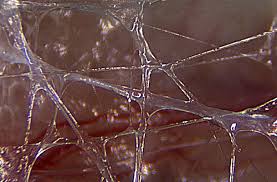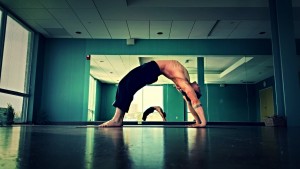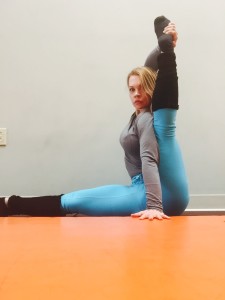Stop Mindless Stretching, Part 2: Flexibility, Fascia, and Your Nervous System

Moving, and stretching out the body.
Flexibility might be the ability of a joint to bend through its full range of motion, but in actuality, it’s the reflection of your nervous system and not simply the more you can stretch, and stretch and stretch some more. (Check out Part 1 of “Stop Mindless Stretching”.) In essence, stretching what is tight or thought to be tight, is often treating the symptom rather than the cause. Hey – it’s the 21st Century – it’s not cool to treat symptoms! Additionally, more range of motion of a joint does not necessarily equate to a better functioning nervous system. Typically, it’s the balance of flexibility from left to right and front to back, that signifies a harmonious nervous system; in other words – symmetry (or maybe harmony is a better way to put it). For example, if you can abduct your left leg 90 degrees but your right leg goes 100 degrees, this doesn’t necessarily mean that the left leg is the problem. After performing a certain therapy or therapies you may find that the right leg is now abducting less, but equal to the left leg, yet it most likely feels less “tight”. The symmetry, as well as the tension, is more important.
If you are under significant physical, emotional or nutritional stress, then your nervous system will respond by tightening certain muscles. That’s just how it works. It’s sort of like a protective mechanism. Maybe your whole body feels tight and you have a stretching routine to “loosen you up” every morning. In this case, there is something affecting your entire nervous system and the muscles are reacting to whatever the problem is. As an example, take the classic waking up with a stiff neck, (or a “crick” in the neck as some call it here in the south). Certainly this may be from poor sleeping arrangements, but more often than not, this problem is due to something you ate the night before. Subsequently this affects your gut and places tension on the lower part of your spine which essentially applies traction down your cervical spine. So your neck hurts. You’re not waking up with a stiff neck because that’s just how it is until you stretch it out, and it’s not stiff because you didn’t stretch before sleep. Sure, stretching might make it feel better but it’s far from addressing the problem.
This isolated neck incident can be viewed systemically too. A lot of inflammation in your body, perhaps from eating too many processed vegetable oils such as corn, soy, and safflower, can result in tight muscles throughout your body because of that influence on your nervous system. A high carbohydrate diet, especially one containing refined sugars, can also make your nervous system more stressed and your muscles feel tight due to the inflammation being created. Too much caffeine, even if it’s loaded with butter and MCT oil, often can give you the muscle aches and tightness along with many other health problems as it puts your body in more of a sympathetic “fight-or-flight” state. Of course, stretching will not help any of these problems although it may provide temporary relief.
Hormonal imbalances can also make your nervous system react in such a way that you have muscular tightness and feel the need to stretch. Women who have estrogen dominance, (or low progesterone), and men with low testosterone levels may experience a tight lower back and hips due to the influence of the testes and ovaries on the muscles in the pelvic region.
But it goes beyond that. Those who understand Eastern medicine and the meridian system know that your organs have emotions associated with them. This is why you can “get sick to your stomach” or get “butterflies” if you’re nervous. Your main brain is talking to your second brain – your gut. All your organs have emotions that are associated with them, and as I’ve discussed often on the Sock Doc site, these organs are also associated to specific muscles. Therefore, your emotions can directly affect your muscles and that can affect your flexibility. Simply put – you might feel tight and that you need to stretch because you’re an emotional wreck or not dealing with an emotional problem in your life.
Don’t Just Not Sit

Sock Doc kid Ava Mae sitting outside, and getting a good stretch while at it.
The dangers of sitting have been all over the news in the past couple years. We all know that the less we actually sit in a chair the better it is for our health and well-being. Many movement advocates target the shortening of our psoas, our major hip flexor muscles, with sitting too much. But the psoas muscles, which some describe as a focal point of structural health, are also associated with our kidneys, fear, and breathing.
Your psoas muscles can quickly become contracted and tight if you’re under a lot of stress beyond that of the physical stress of sitting all day at work. Many people, because of the amount of sympathetic stress on their nervous system, experience these tight, shortened flexors. The emotion of fear, even if it’s not readily perceived by the individual, further exacerbates this. Think about it – even if you don’t obviously know something you’re fearful of, your nervous system does. A sympathetic dominant body is a fearful state – it’s as if your body is ready to fight and trying to survive. Furthermore, the psoas has fascial connections to your diaphragm – yes that muscle you should be using a lot more than your lungs to breathe! Diaphragmatic breathing is parasympathetic – the opposite of sympathetic. What do we all do when we are under stress? Well we breathe shallow or hold our breath of course. The worse our breathing becomes, the tighter our psoas and other muscles become. The greater frequency of this phenomena happening, the more sympathetic dominant we become and that in turn, creating more and more tightness. So yes – get up and move if you’re sitting too much. But if you’re drinking coffee, eating sugary snacks, not breathing, and hate your job – you’ll never stretch your way out of it.
Muscles are so Yesterday. Fascia is Where It’s All At.
Your fascia – the connective tissue that holds us together like a thick, gluey, spider web – is paramount when discussing flexibility. It’s not that muscles are no longer important, but it’s your fascia that is more responsible for stability, movement, and yes, flexibility.
Fascia is so much more than the collagenous tissues of the body that everyone talks about. It’s also the cells that make up the extra-cellular matrix (ECM). Yes, your tiny cells that make up everything in your body.
This fascia, particularly the non-fibrous fascia, can change very, very quickly – yes, within seconds. This, in turn, can and will result in improved flexibility and ease of movement immediately. The fascial web integrates everything you come in contact with whether it’s physical, chemical, or emotional. This is why your emotional well being, your nutritional and hormonal status, and how well you breathe can affect your flexibility immediately. Stop stretching and breathe!
Gel Fascia

Gooey gel fascia
Your body is two thirds water but our molecules are 99% water. Muscle contraction and cell biology researcher Dr. Gerald Pollack discusses how gel is the fourth phase of water, somewhere in-between the solid and liquid state. This gel constituent of fascia is important for determining viscoelasticity of tissue, such as fascia, and it forms the conductive channels of the meridian system. This gel phase is now what is being thought of as being altered during manual therapies, in addition to but perhaps more so than the more rigid fascia matrix.
Time to get a bit nerdy. Don’t be scared or it’ll just lock up your psoas. Our cartilage contains aggrecan, a proteoglycan. Proteoglycans, such as chondroitin sulfate, make up our connective tissue and help repair our tissues via glycosaminoglycans (GAG) synthesis. Aggrecan is also involved in cell adhesion and the binding of hyaluronic acid, a sort of gel-like molecule. Hyaluronic acid is also a GAG and it acts as one of the body’s main lubricating components. When the protein aggrecan binds to hyaluronic acid they take in water and greatly affect the resilience of cartilage. Dr. Carla Stecco, Assistant Professor of Human Anatomy and Movement Sciences at the University of Padova, Italy, notes that the abundance of this gel-like material can vary simply due to temperature as well as pH. This is why that something as simple as a hot shower can help “loosen you up” and the theory also gives merit as to how a warm-up before activity helps you move better. The HA in loose connective tissue is the most widespread connective tissue in the human body. But these water-absorbing proteins in our extracellular matrix are actually lengthening and contracting all the time as we move throughout the day.
“Fascial Fitness”
Our ECM is a body-wide communication system that needs to function optimally in order for us to function optimally. From the basic cells that support the framework of our body via tension as well as relaxation, this living matrix can be influenced by how we move, how we live, what we eat, how we think and how we interact with others, including those who perform manual therapies on our tissues. Or, perhaps it is better for me to say – on our molecules. Manual therapies such as chiropractic, massage, acupuncture, and movement therapies can reverse changes in the HA and therefore change pain and range of motion immediately by changing adhesive HA to lubricating HA. This change allows our joints and connective tissue to glide with more ease and efficiency.
To put those last two paragraphs more simply – the gooey fascia of our body can change in the blink of an eye by how we breathe, what we think, what we eat and drink, how we interact with our environment, and who we interact with.
Human Variations Affect Flexibility

Kellen: Tense where he needs to be, and relaxed where he needs to be. Photo credit: Matthew Anderson Photography
Tension is when tissues resist to some factor of stress that is asking the tissues to elongate. This tensile resistance can be from muscles, tendons, ligaments, myofascial meridians, or even cell structure as discussed earlier. Joint capsules and muscles contribute to about 90% of tension. Much of the joint capsule and 30% of muscles are fascia, so it is often much more than ‘a tight muscle’ that is limiting flexibility or normal range of motion. Factors that could be causing tension in the body and interfering with this normal range of motion include a nervous system which may be under stress, the presence of fascial adhesions or some sort of pathology, an immune system impairment, psychological stress, or poor movement patterns. No matter how much you want to stretch, if your immune system is impaired and you’re under a lot of stress, then your flexibility will be at best, short lived.

Keira – only limited by compression
Flexibility is not just a balance of tension and relaxation, but it also takes into account compression. Compression is the impingement of one tissue upon another such as flesh on flesh or bone on bone, or the body coming into contact with itself with the inability to go any further. Pelvic angles, femur variations and other anatomical variants will determine, to some degree, how well you do or don’t move in a certain direction. Yes, sometimes there are ways around a structural limitation, but not always. Never forget how unique you are as an individual and accept that you may have reached a fundamental limit in your flexibility based upon compression rather than tension. Sometimes, you just can’t go any further. You can’t stretch past tissue hitting tissue!
Next up: movement and mobility, to be discussed in Part III. I’ll also talk about yoga – what everyone still thinks is a stretching program – and that way of thinking is just getting annoying and tightening up my fascia.
 Consult with
Consult with Sock Doc Workshops
Sock Doc Workshops
Sean Flaherty says
Awesome!
Barbara says
So how do we increase our flexibility?
Thank you
Dr. Stephen Gangemi "Sock Doc" says
Please see the Stretching series on this site.